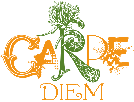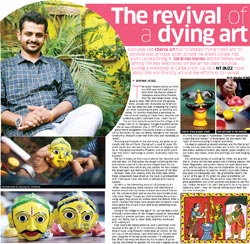
The revival of a dying art

The lesser-known Cherial art form is a 400-year-old traditional art form from the Deccan states of Telangana and Andhra Pradesh, that has seen tough times, struggling to keep itself alive over the generations. 24 years old Dhanaloka Sai Kiran Varma has taken the lead in keeping the Cherial art alive, something he grew up watching and doing. He recently conducted a workshop on Cherial mask making at Carpe Diem, Majorda and curated by public charitable trust, 'Heart For Art'.
The art form takes its name from the village of its origin 'Cherial' in Telangana. Though it existed earlier, the art was christened only in 1976 after it received government recognition. Prev'iously known as Nakashi art by the locals, Sai says his family belongs to the Nakashi community. (Nakashi is derived from Urdu and translates as artist').
Teaching participants at the workshop, Sai gives us an insight into the art form. Cherial art is used to make life sized masks that are worn by performers at religious melas in Telangana and Andhra Pradesh: and in scroll paintings that depict mythological scenes, especially made for travelers.
The eco-friendly art form uses material like tamarind pulp and saw dust. Sai first makes the dough combining the two and moulds a part of it into an oval-shaped base for the mask. This was then left to dry and harden. He then kneads the dough again and fashions this into features of the face - the eyes, nose, chin, cheeks, onto the dried base. When these components have dried up, the mask is whitewashed with chalk paste. Later, the mask is painted with natural colours.
Sai tells us the interesting story of his journey in art “When was studying, many national and international tourists would visit my house to know more about Cherial art. The communication barrier was the main hurdle as we only knew Telugu. Though we tried explaining the process using signs, they would be unclear about the details. After a point realised that there were people who wanted to know more about this art and it was time to do something to expand its reach."
Living in his village till the age of 16, Sai had seen a kind of exodus where many of the villagers moved to Hyderabad in search of greener pastures, leaving behind their art in peril. His family had no other skills, and they continued with a dying art.
Fate turned the tables when Sai held a workshop in Hyderabad at the age of 17 "I conducted a three-day workshop in Salar Jung Museum, Hyderabad on Cherial. On the last day of the workshop, I was felicitated by Surabhi Vani Devi, daughter of former prime minister, PV Narasimha Rao. When she enquired about my future plans of pursuing the, she offered to sponsor my five years degree course in a Fine Arts college in Hyderabad. I have now specialised in painting and murals." In Hyderabad, Sai also learnt the ropes of communicating in English and Hindi.
His degree opened up several avenues and his Cherial art is now not only restricted to masks and scrolls, but today he also makes spectacle holders, gen stands, paper weights, tissue boxes, key chains, small wall paintings and wall hanging masks
His childhood hobby of assisting his father and grandfather in Cherial art has now grown into a lifelong passion His father Nageshwar and mother Padma are state award winners, and Sai says that they are his inspiration. As Sai wraps up the conversation, he says his family's tryst with Cherial was quiet an unexpected one: "My grandfather learnt Cherial art at the age of 35 when my great grandfather suffered a paralytic stroke. The art would have died with my great grandfather, but it has survived and grown to see this day. I enjoy the work do, and feel glad to be in my space especially when hear my friends talking about their tedious nine to five jobs."





